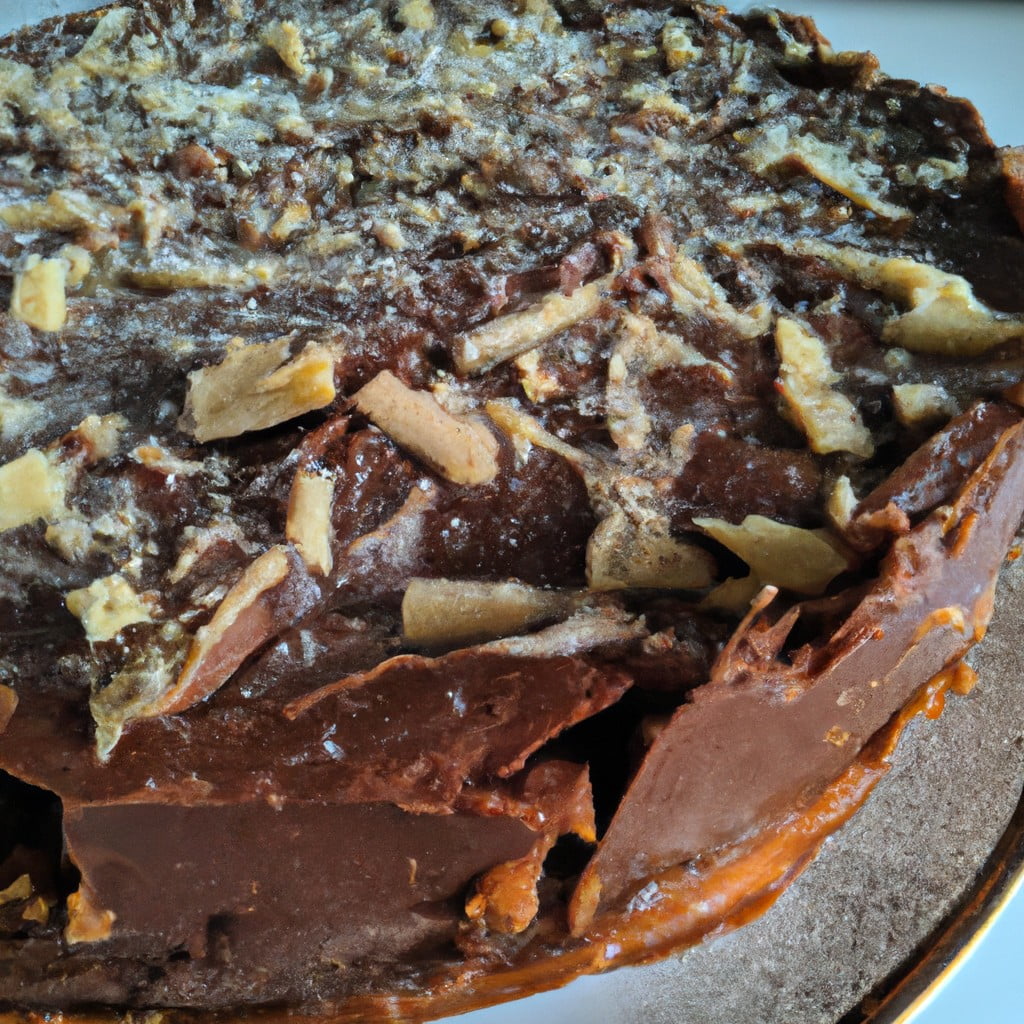This article provides step-by-step instructions on how to make an authentic German chocolate cake, ensuring success even for novice bakers.
Key takeaways:
- German Chocolate Cake is a layered cake with a sweet filling of toasted pecans and shredded coconut.
- Traditional recipes do not include black forest cherries or liqueur flavors.
- Key ingredients for the cake include sugar, flour, cocoa powder, eggs, buttermilk, and vegetable oil.
- Coconut-pecan filling is made with evaporated milk, egg yolks, sugar, and butter.
- Assemble the cake by spreading the filling between the layers and optionally frosting the sides with chocolate icing.
Inside
What Is German Chocolate Cake?

This indulgent cake owes its name not to the country of Germany, but to an American by the name of Samuel German, who developed a type of dark baking chocolate for the Baker’s Chocolate Company.
The cake’s signature is its layered structure, typically involving a sweet, gooey filling of toasted pecans and shredded coconut.
The rich, moist layers of chocolate sponge are often enhanced with a distinct caramel flavor note, achieved by employing brown sugar in the mix.
Despite a common misconception, traditional recipes do not typically include black forest cherries or liqueur flavors associated with German confectionery.
The cake is completed with a chocolate frosting, although the coconut-pecan filling often also serves as a topping, creating a visually striking and flavorful contrast.
Ingredients for German Chocolate Cake
To prepare a traditional German Chocolate Cake, you will need the following components:
- Granulated sugar: The sweet base of the cake.
- All-purpose flour: Gives structure to the cake.
- Unsweetened cocoa powder, preferably dark: Provides the rich chocolate flavor.
- Baking powder and baking soda: Leavening agents that help the cake rise.
- Salt: Enhances other flavors in the cake.
- Eggs: Bind the ingredients together and create a smooth texture.
- Buttermilk: Adds moisture and a slight tang, helping to balance the sweetness.
- Vegetable oil: Keeps the cake moist.
- Vanilla extract: A flavor enhancer.
- Hot water or coffee: Helps to bloom the cocoa powder, intensifying the chocolate taste.
For the coconut-pecan filling and topping:
- Egg yolks: Thicken the custard-like filling.
- Evaporated milk: Provides creaminess without the added fat of heavy cream.
- Granulated sugar and brown sugar: Sweeten and add a slight molasses note with the brown sugar.
- Butter: Adds richness and helps to thicken the filling.
- Vanilla extract: Complements the sweetness and adds depth.
- Sweetened flaked coconut: Adds texture and distinct flavor to the filling.
- Chopped pecans: Provide crunch and nuttiness, a signature characteristic of the cake.
The listed ingredients are integral to creating the authentic flavors and textures characteristic of a classic German Chocolate Cake. Remember to have all ingredients measured and prepared before beginning the baking process to simplify the steps and ensure a smooth cake-making experience.
Coconut-Pecan Filling Recipe
To create the coconut-pecan filling, a combination of evaporated milk, sugar, egg yolks, and butter is cooked over medium heat until thickened. Stirring constantly is crucial to prevent the eggs from scrambling and to ensure a smooth consistency.
This mixture acts as a binder for the shredded coconut and chopped pecans, which are folded in once the custard reaches a golden hue. The cooling stage is important as it allows the filling to thicken further, creating the perfect spreadable consistency needed for layering within the cake.
When spreading between layers, be sure to leave a small border to prevent the filling from oozing out when the layers are stacked.
Chocolate Cake Batter Preparation
Begin by preheating your oven to 350°F (175°C) and lightly greasing or lining your cake pans with parchment paper. This ensures easy removal of the cakes after baking.
For the dry ingredients, sift together flour, cocoa powder, baking soda, and salt in a bowl, promoting an even distribution and eliminating any lumps that could affect the cake’s texture.
In a separate bowl, cream the sugar and butter until the mixture is light and fluffy, then add eggs one at a time, fully incorporating each before adding the next. This process introduces air into the batter, contributing to a lighter cake.
Incorporate the dry ingredients into the butter mixture in parts, alternating with buttermilk to maintain moisture, and then stir in the vanilla extract. Adding these elements in stages helps retain the airiness achieved during the creaming process.
Lastly, gently fold the chocolate, which should be melted and cooled, into the batter ensuring it’s evenly mixed without overworking it. This step infuses the batter with a rich, chocolatey flavor without compromising its airy texture. Pour the batter into prepared pans, taking care to divide it evenly, and smooth the tops with a spatula.
Bake the cakes until a toothpick inserted into the center comes out clean, which usually takes about 30-35 minutes. Cool the cakes in the pans for 15 minutes, then transfer to a wire rack to cool completely. Cooling is crucial; warm cakes can cause the filling to melt, leading to a potentially messy assembly.
Assembling the Layers
Begin by ensuring your cake layers are completely cooled; this prevents the filling from melting.
Place the first layer on your serving plate and spread a generous amount of coconut-pecan filling over the top, leaving a small border around the edges to allow for spreading when the next layer is added.
Gently set the second layer on top of the first and repeat the process with more filling.
Add the final cake layer and cover the top with the rest of the filling, allowing some to spill over the sides for a rustic look.
For a more polished finish, you can also frost the sides with chocolate icing before adding the coconut-pecan filling.
Remember to work delicately, as the moist cake layers can break if handled too roughly.
After assembling, the cake benefits from chilling for a short period to help the layers set, resulting in easier slicing.